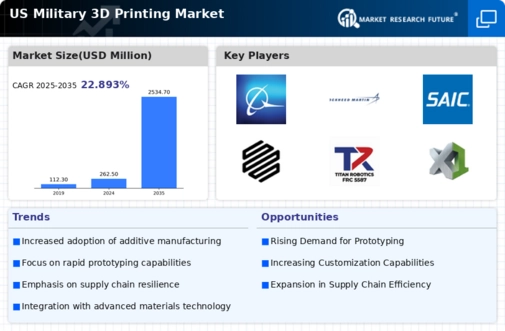Supply Chain Resilience
Supply chain resilience is an increasingly critical driver in the US military 3D printing market. The military's reliance on complex global supply chains poses risks, particularly in times of geopolitical tension or natural disasters. 3D printing offers a solution by enabling localized production of essential components, thereby reducing dependency on external suppliers. The Department of Defense has recognized this potential, investing in 3D printing technologies to enhance supply chain robustness. By establishing on-site printing capabilities, military units can produce necessary parts in remote locations, ensuring operational continuity even in challenging circumstances. This shift towards localized manufacturing not only enhances resilience but also contributes to faster response times and reduced logistical burdens, aligning with the military's strategic objectives.
Customization and Adaptability
Customization and adaptability are pivotal factors driving the US military 3D printing market. The unique requirements of military operations necessitate tailored solutions that traditional manufacturing cannot easily provide. 3D printing allows for the production of bespoke parts and equipment that meet specific mission needs, enhancing the effectiveness of military operations. For example, the Navy has utilized 3D printing to create customized tools and components for specific vessels, improving functionality and performance. This level of customization not only improves operational efficiency but also reduces the need for extensive inventories of spare parts, as components can be printed as needed. The adaptability of 3D printing technologies to various materials and designs further supports the military's diverse operational requirements, making it a vital component of modern military logistics.
Rapid Prototyping Capabilities
The ability to rapidly prototype is a crucial driver in the US military 3D printing market. This technology allows for the swift development of new designs and modifications to existing equipment, which is essential in a fast-paced military environment. The military can quickly test and iterate on designs, significantly reducing the time from concept to deployment. For instance, the Army's use of 3D printing has enabled the production of prototype parts within days, compared to traditional methods that could take weeks or months. This agility not only enhances the military's operational capabilities but also fosters innovation, as engineers can experiment with new ideas without the constraints of conventional manufacturing timelines. The emphasis on rapid prototyping is likely to continue as the military seeks to maintain a technological edge over potential adversaries.
Advancements in Material Science
Advancements in material science are significantly influencing the US military 3D printing market. The development of new materials suitable for 3D printing, such as high-strength polymers and metal alloys, expands the range of applications for additive manufacturing in military contexts. These materials enable the production of components that meet stringent performance and durability standards required in military operations. For instance, the Air Force has explored the use of advanced materials to create lightweight yet robust parts for aircraft, enhancing fuel efficiency and overall performance. As research continues to evolve, the potential for new materials to revolutionize military manufacturing processes appears promising. The integration of these advanced materials into 3D printing practices not only supports innovation but also aligns with the military's goals of improving operational effectiveness and reducing lifecycle costs.
Cost Efficiency in Manufacturing
The US military 3D printing market is increasingly driven by the need for cost efficiency in manufacturing processes. Traditional manufacturing methods often involve high labor and material costs, which can be mitigated through 3D printing technologies. By utilizing additive manufacturing, the military can produce components on-demand, reducing inventory costs and minimizing waste. Reports indicate that 3D printing can lower production costs by up to 70% for certain parts, which is particularly beneficial for the military's budget constraints. This cost efficiency not only allows for better allocation of resources but also enables rapid prototyping and production of critical components, enhancing operational readiness. As the military seeks to modernize its supply chain, the integration of 3D printing technologies appears to be a strategic move to achieve financial sustainability while maintaining high standards of quality and performance.

















Leave a Comment